
A lesson plan to introuduce types of technology and basic hardware to kindergarten students.
- Subject:
- Computing Systems
- Material Type:
- Activity/Lab
- Author:
- Barbara Matney
- Date Added:
- 04/18/2022

A lesson plan to introuduce types of technology and basic hardware to kindergarten students.

Website resource to help early CS learners identify parts of a computing system
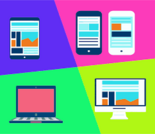
This Quizlet Study Set contains Kindergarten and Grade 1 vocabulary (with pictures) from the "Computing Systems" strand of the Virginia Standards of Learning for Computer Science.
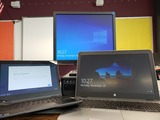
This slides presentation has a short video about the 4 things that all computing devices have in common and then has picture examples of Input and output devices. It also has a slide of internal components we don't usually see.The final slide is a sorting activity that includes input and output devices.
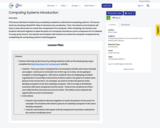
This lesson will teach students key vocabulary needed to understand computing systems. The lesson starts by showing a BrainPOP video to introduce key vocabulary. Then, the teacher and students will have a class discussion to review the components of a computer. After reviewing, the teacher and students will work together to label the parts of a computer and discuss each component as it is labeled. To wrap up the lesson, the teacher and students will continue to review the computer components by completing the computing systems matching game.
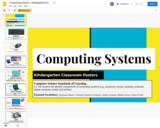
This is a set of printable classroom posters with images and basic terminology for kindergarten students.
The terminology covered is as follows:
Keyboard
Mouse
Trackpad
Desktop computer
Laptop computer
Mobile Device
Tablet
Printer
You may make a copy of the posters. Please feel free to add any additional information or edit the slides to best suit your student's needs.

Teachers read aloud an eBook about computer systems. Teacher guide includes questioning activities and suggested follow-ups for after reading.

A lesson plan with activity that introduces computer hardware and software to the primary grades.

Quizelt Vocabulary Set to introduce Hardware/Software to primary grades.
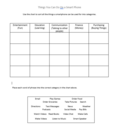
Students identify components of computing systems and sort different computing tasks into categories.

These posters define the vocabulary for K-2 Computing Systems SOLs in pictures and words.
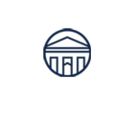
The student will learn parts of a computer by exploration and creating their own computer.

Students will conduct an apple investigation that includes if the apple sinks or floats, the number of seeds inside, the weight of the apple, and even a taste test. They will also have the chance to make an apple life cycle spinner.

This is a two day lesson. The first day is a lesson about the history of computers. The students will look at pictures of past computers, computers of today and then discuss what they think the computers of the future will be like.The second day, the students will be looking at components of computers with several fun and exciting stations to help them learn the names of the components (parts and types) of computers such as, desktop computer, laptop computer, tablets, mouse, CPU, printer, etc.

Take the “User Friendly” approach to increase your students' knowledge of computing systems with this simple and fun lesson. Students will be able to identify basic computer components, compare hardware vs software, and troubleshoot simple problems when using their tablets.

Students will learn the basic parts of a desktop computer through the hands on building of an air dry clay model. Students will have to label the parts of the computer by placing toothpicks with small labels on them into the model at the appropriate place.
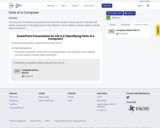
This resource is a PowerPoint presentation that covers the Computer Science SOL K.5: The student will identify components of computing systems (e.g., keyboard, mouse, desktop computer, laptop computer, tablet, and printer).

This is a visual that may used as a poster in the classroom to aid students in learning the parts of a computer.

This slideshow is intended for Pre K and Kindergarten teachers for introducing students to technology vocabulary.The slides include a bried definition and images to support learning.